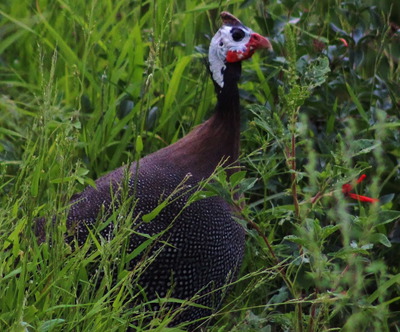 Back in the late 1980s, as Lyme disease became identified as a serious problem for people and pets in Westchester County, scientists and the general public came up with a possible “natural” solution – guinea fowl.
Back in the late 1980s, as Lyme disease became identified as a serious problem for people and pets in Westchester County, scientists and the general public came up with a possible “natural” solution – guinea fowl.
By Bill Lawyer
 Back in the late 1980s, as Lyme disease became identified as a serious problem for people and pets in Westchester County, scientists and the general public came up with a possible “natural” solution – guinea fowl.
Back in the late 1980s, as Lyme disease became identified as a serious problem for people and pets in Westchester County, scientists and the general public came up with a possible “natural” solution – guinea fowl.
Guinea fowl, which are genetically related to pheasants, partridges, and other types of fowl, were brought into the United States for culinary, commercial, sporting, and fancy breeding purposes.
Adult guinea fowl are fairly large – 16 to 28 inches in length, and 2 to 4 pounds. They look a little bit like juvenile turkeys. In fact, one of the common names for them is guinea hens (despite the fact that the term hen generally refers to a female, and guinea fowl come in both sexes).
Through centuries of breeding there are now many different color combinations (gray, lavender, nearly black) and variations in heads – some have spots (known as pearls) and some don’t. Some look like vultures, some have crested or helmeted heads.
Scientists have traced their origin to various regions of Africa, but guinea fowl have been domesticated in Europe and other continents for centuries.
Lyme disease and related bacterial illnesses are spread by deer ticks, which feed on the blood of various types of mammals, ranging from small deer mice to deer, raccoons, and skunks.
While the disease can be treated with various types of antibiotics, people began looking for ways to get rid of the ticks before they had the chance to spread the disease in the first place.
While chickens and turkeys are known to feed on ticks and other types of invertebrates, it didn’t seem practical to turn such domesticated animals loose in the woodlands and suburbs of Westchester.
However, various scientists and fancy fowl breeders hit upon the idea of utilizing guinea fowl. Various species of guinea fowl are only partially domesticated, so they stood a good chance of being able to hold their own if turned loose into the wild. They can supposedly eat up to 1,000 ticks per day!
Well, perhaps the high point of the great guinea fowl solution came when supermodel Christie Brinkley made the news in 1990 by having some of the “tick-avore” fowl released on her palatial property in the Hamptons.
Unfortunately, despite the efforts of Brinkley and others, Lyme disease persists as a health hazard for people venturing into the woods and bushy parklands – requiring people who enjoy outdoor experiences to carry out tick-checks on a regular basis.
Years went by with little or no mention of guinea fowl and their potential protective powers against Lyme. Even though guinea fowl can fly, they are still susceptible to being preyed upon by coyotes, raccoons, and feral cats (the chicks, as guinea fowl are ground-nesters) – to say nothing of automobiles.
However, this past year, Westchester and surrounding areas experienced much warmer than usual temperatures. Perhaps for this reason people began to notice a higher than normal tick population.
The New York Post printed a story in July about a poultry farm in New Jersey that was getting customers from Westchester to buy guinea fowl for tick control.
Thus, it may be that someone in Rye decided to step up and try to bring back the guinea fowl formula for tick control. In mid-July people in the Rye Gate neighborhood and Rye Beach Avenue began seeing a flock of five guinea fowl nibbling its way from yard to yard.
Mostly, they were seen early in the morning, and in the still dark dawn it was hard to tell if they were immature turkeys or what. But a closer look at their heads and body shape made it clear these were not turkeys.
Being an early riser and bike rider, during the summer I saw families of turkeys parading on the grounds of Coveleigh Club and people’s yards in Milton Point, and you can tell the difference.
Recently, on two occasions, I saw five guinea fowl holding a “tick-fest” on a lawn near the south end of Forest Avenue. Was it the same flock of five birds I saw back in July? Have they been working their way south all this while?
Well, I don’t have the answers to these questions, but that’s what makes nature study so much fun — trying to find out. So, if someone in Rye is pulling a Christie Brinkley on us, right in our backyards, please let me know!















